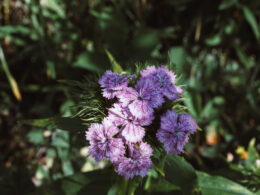What Is Wheatgrass? Characteristics and Benefits
The name wheatgrass refers to the freshly sprouted first leaves of common wheat (Triticum aestivum). Unlike wheat malt, they’re served fresh or freeze-dried, and are allowed to grow taller before harvesting. So, if you’re curious how to grow wheatgrass, the short answer is: by growing wheat!
Wheatgrass is often used for juicing, and can be added to smoothies. It has a high concentration of chlorophyll, which is the green pigment that helps plants convert sunlight into energy. Chlorophyll is also thought to have detoxifying, antioxidant, and anti-inflammatory properties.
In addition, wheatgrass is a rich source of vitamin E, phosphorus and iron. It also contains amino acids and enzymes that are thought to boost energy levels. Its nutritional content can be compared to broccoli and spinach. Some people say it can help to prevent cancer, but these claims haven’t been proven.
While wheatgrass is generally considered safe, it’s important to talk to your doctor before adding it to your diet, especially if you have celiac disease or a gluten intolerance.
How to Grow Wheatgrass at Home – Sprouting Wheat Seeds
Now, let’s get into how to grow wheatgrass, either with or without soil. The first step for both versions is sprouting wheat seeds. You’ll need a sprouting container (a mason jar with a cheesecloth or coffee filter secured over the top works well), wheat seeds, and filtered water.
Start by rinsing the seeds, putting them in the container and soaking them in 1 cup of water for 8 hours. Then, drain the water and rinse the seeds again. Fill the container with fresh water, turn it upside down (letting the water drain through the cloth or filter), and leave it like that.
Place the container in a warm, dark place and rinse the seeds 2-3 times a day. Within 24-48 hours, they should start to sprout. Once the wheatgrass seeds have sprouted, you can either plant them in soil or continue growing them hydroponically without soil.
Growing Wheatgrass in a Tray With Soil
If you want to grow wheatgrass in a tray with soil or another growing medium, you’ll need:
- sprouting seeds (prepared with the method above);
- organic compost or potting mix;
- a tray with holes at the bottom.
Start by adding an inch-thick layer of potting soil to the bottom of the tray. Then, water the soil and sprinkle the seeds on the surface. Gently press the seeds into the soil. Cover the tray with a lid or newspaper and mist the seeds with a spray bottle every day. When the grass is about 1-2 inches tall, remove the lid and continue to water your wheat daily.
Growing Wheatgrass – The Soilless Method
If you choose to grow wheatgrass without soil, also known as hydroponically, you’ll need:
- sprouting wheatgrass seeds;
- a flat container without holes;
- a cloth to cover the container;
- fresh water.
Follow the steps above to sprout your wheatgrass seeds. Then, place them in the container of your choice, fill it with water and cover it with a cloth – only for the first day or two, then take it off. Drain and rinse the seeds 2-3 times a day, just like before. Within a few days, the wheatgrass will start to grow.
The Optimal Temperature and Light for Wheatgrass Growth
For both methods, it’s important to find a warm spot in your home with indirect light. The optimal temperature for wheatgrass growth is between 60 and 75 degrees Fahrenheit. If it gets too hot, the grass will dry out quickly. You can grow wheatgrass indoors all year round, but it grows best in spring and summer, when the days are longer.
When Is Your Wheatgrass Ready to Harvest?
You can start harvesting wheatgrass when it reaches about 5 inches in height, which is usually 7-10 days after sprouting. Cut the grass as close to the roots as possible without damaging them, using a sharp knife or scissors. Rinse it with filtered water and enjoy!
Wheatgrass is best used freshly after harvesting, but you can also store it in the fridge for a few days. If you want to keep it for longer, you can juice it and freeze the juice in ice cube trays.
How to Use Your Wheatgrass – 10 Easy Ways
Now that you know how to grow wheatgrass at home, let’s explore some ways to use it. Here are ten of our favorites:
- Add wheatgrass to a smoothie or green juice made with a juicer.
- Dry it and grind it into a powder, then mix it into water, juice or a smoothie.
- Add it to pesto or guacamole for an extra boost of vitamins and minerals.
- Make wheatgrass ice cubes and add them to water or juice.
- Use it as a garnish on soup, salad, grains or rice dishes.
- Use wheatgrass in place of parsley or cilantro in recipes.
- Make a wheatgrass shot by juicing it and drinking it on its own.
- Add wheatgrass juice to a bath for a relaxing, detoxifying experience.
- Blend it into homemade green cleaning products.
- Compost the leftover wheatgrass when you’re finished juicing or using it in recipes.
While wheatgrass is considered to be a health food, it’s important to remember that it’s not a remedy for everything. Wheatgrass can also act as a natural laxative, so it’s not recommended for those with digestive issues. And if you’re pregnant or breastfeeding, please consult your healthcare provider before adding wheatgrass to your diet.
Enjoy Your Homegrown Wheatgrass in Any Way You Like
Now that you know how to grow wheatgrass and use it, give it a try! We think you’ll be surprised at how easy it is to grow this nutrient-packed plant at home. And once you start using wheatgrass in recipes and juicing, you’ll be hooked on its fresh, grassy flavor. Have fun experimenting!



















